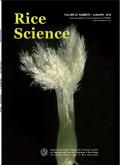Global Transcriptome Analysis of Rice Seedlings in Response to Extracellular ATP
IF 6.1
2区 农林科学
Q1 AGRONOMY
引用次数: 0
Abstract
Herbivorous insects and pathogens cause severe damage to rice tissues, affecting yield and grain quality. Damaged cells trigger downstream defense responses through various signals. Extracellular ATP (eATP), a signaling molecule released during mechanical cell damage, is considered a constitutive damage-associated molecular pattern (DAMP), which is crucial for initiating plant defense responses. Thus, understanding how rice plants cope with DAMPs such as eATP is essential. Here, we found that exogenous ATP affected rice growth and development, cell wall composition, chloroplast development, and cell death. Subsequent global transcriptome analysis revealed that several pathways were involved in the eATP response, including genes related to cell surface receptors, cell wall organization, chlorophyll biosynthesis, heat and temperature stimulation, epigenetic regulation, and reactive oxygen species metabolism. Cell surface receptors, including members of the lectin receptor-like kinases (LecRKs), were found to participate in the eATP response. We further investigated ATP-induced genes in T-DNA activation mutants of OsLecRKs, demonstrating their involvement in eATP signaling in rice. This study confirms a DAMP-mediated transcriptional response in plants and provides novel candidates for advancing resistant rice breeding against insect herbivores and pathogens.
水稻幼苗对细胞外ATP响应的转录组分析
草食性昆虫和病原体对水稻组织造成严重损害,影响产量和稻米品质。受损细胞通过各种信号触发下游防御反应。细胞外ATP (eATP)是细胞机械损伤过程中释放的一种信号分子,被认为是一种本构性损伤相关分子模式(DAMP),在启动植物防御反应中起着至关重要的作用。因此,了解水稻植物如何应对像eATP这样的damp是至关重要的。在这里,我们发现外源ATP影响水稻的生长发育、细胞壁组成、叶绿体发育和细胞死亡。随后的全球转录组分析显示,eATP反应涉及多种途径,包括与细胞表面受体、细胞壁组织、叶绿素生物合成、热和温度刺激、表观遗传调控和活性氧代谢相关的基因。包括凝集素受体样激酶(LecRKs)成员在内的细胞表面受体被发现参与了eATP反应。我们进一步研究了OsLecRKs T-DNA激活突变体中的atp诱导基因,证实了它们参与水稻eATP信号传导。该研究证实了植物中damp介导的转录反应,为推进水稻抗虫、抗草食动物和抗病原体育种提供了新的候选材料。
本文章由计算机程序翻译,如有差异,请以英文原文为准。
求助全文
约1分钟内获得全文
求助全文
来源期刊

Rice Science
Agricultural and Biological Sciences-Agronomy and Crop Science
CiteScore
8.90
自引率
6.20%
发文量
55
审稿时长
40 weeks
期刊介绍:
Rice Science is an international research journal sponsored by China National Rice Research Institute. It publishes original research papers, review articles, as well as short communications on all aspects of rice sciences in English language. Some of the topics that may be included in each issue are: breeding and genetics, biotechnology, germplasm resources, crop management, pest management, physiology, soil and fertilizer management, ecology, cereal chemistry and post-harvest processing.
 求助内容:
求助内容: 应助结果提醒方式:
应助结果提醒方式:


